*NURSING > QUESTIONS & ANSWERS > NSG 125 Questions Unit 1 and 2 Answered correctly summer 2022. (All)
NSG 125 Questions Unit 1 and 2 Answered correctly summer 2022.
Document Content and Description Below
NSG 125 Practice Questions Unit 1 and 2 1. A client is taking triamterene-hydrochlorothiazide (Dyazide) and furosemide (Lasix). What assessment finding requires action by the nurse? A. Cough B. He... adache C. Pulse of 62 beats/min D. Potassium of 2.9 mEq/L 2. The nurse is preparing to administer a beta-blocker to the client diagnosed with coronary artery disease. Which assessment data would cause the nurse to question administering the medication? A. The client has a BP of 110/70. B. The client has an apical pulse of 56. C. The client is complaining of a headache. D. The client’s potassium level is 4.5 mEq/L 3. The nurse is receiving report on a 45 year old client status post MI 2 days ago. The telemetry monitor alarms and the following rhythm is noted. What should document as this rhythm? A. Sinus rhythm B. Sinus rhythm with premature ventricular contractions C. Sinus rhythm with premature atrial contractions D. Sinus rhythm with a run of ventricular tachycardia4. A client presents to the emergency department with hypoventilation and has a respiratory rate of 10 breaths/minute. The ECG monitor displays tachycardia, with a heart rate of 120 beats/minute. Arterial blood gases are drawn and the nurse reviews the results, expecting to note which finding? A. An increased pH and a decreased CO2 B. A decreased pH and an increased CO2 C. A decreased pH and a decreased HCO3 D. An increased pH with an increased HCO3 5. What is the priority goal for a client admitted with left sided heart failure? a. Client’s lung sounds will be clear, weight will return to baseline, and will be able sleep on one pillow by time of discharge. b. Client’s RR will be 12-20/min, HR between 60-100, SBP 100-140 when walking by time of discharge. c. Client will have no pitting edema, jugular vein distention, or abdominal ascites by time of discharge. d. Client will not have chest pain, ST segment changes, or cold clammy skin during hospitalization. 6. A client is diagnosed with heart failure is prescribed carvedilol (Coreg). The nurse should consult with the health care provider before giving this medication upon finding a history of: A. Asthma. B. Peptic ulcer disease. C. Alcohol dependency. D. Myocardial infarction (MI). 7. A client comes into the ER complaining of chest heaviness, dyspnea, and left arm pain. The patient is triaged at the bedside. He is placed on the bedside monitor. A 12-lead EKG is obtained and an IV has been started. What is your next immediate intervention(s) that you should anticipate? A. Schedule an emergency cardiac catheterization to evaluate coronary artery blockages B. Prepare the client for immediate electroshock therapy. C. Order a stat chest x-ray and start an albuterol neb treatment. D. Apply oxygen and administer SL nitroglycerin, morphine, and an aspirin8. A client has severe dyspnea. Which of the following assessment findings indicates to the nurse that the respiratory problem is a chronic issue indicative of COPD? A. Wheezing on expiration. B. Productive cough. C. Clubbed fingers. D. Diaphoresis. 9. A 62 year-old client with COPD has been admitted to the medical floor for left lower lobe pneumonia. He is having difficulty clearing secretions from his lungs. What is the best nursing intervention to support this client with clearing secretions? A. Monitor pulse oximetry every 4 hours. B. Encourage increased fluid intake as tolerated. C. Assess level of patient anxiety. D. Give him cough suppressants as ordered by his doctor. 10. The nurse is assessing a client with chronic anemia. Which clinical manifestation does the nurse expect to see in this client? A. Dyspnea with activity B. Hypertension C. Bradycardia D. Warm, flushed skin 11. The nurse reviews the blood gas results of a client with atelectasis. The nurse analyzes the results and determines that the client is experiencing respiratory acidosis. Which results validates the nurse’s findings? A. pH 7.25, PCO2 50 mm Hg B. pH 7.35, PCO2 40 mm Hg C. pH 7.50, PCO2 52 mm Hg D. pH 7.52, PCO2 28 mm Hg . 12. The nurse is planning care for a client who has a platelet count of 30,000/mm3. Which intervention does the nurse include in this client’s plan of care? A. Oxygen by nasal cannula B. Bleeding Precautions C. Isolation Precautions D. Vital signs every 4 hours13. When providing health teaching for the client with COPD, the nurse educates the client on the side effects that may occur with the use of bronchodilators. What possible clinical manifestations should the client be aware of? (Select all that apply) A. Bradycardia B. Nervousness C. Tremors D. Drowsiness E. Palpitations 14. A client in the ER presents with HR: 127, BP: 197/104, RR: 22, T: 102.0, and SpO2: 86%. Physical assessment shows cough with pink frothy sputum, distended jugular veins, and crackles in all lung fields. The nurse can reasonably expect which pharmacological interventions: A. Metoprolol IV, oxygen, nitroglycerin gtt, furosemide IV B. Oral antibiotics, an IV fluid bolus of normal saline, acetaminophen, albuterol inhaler C. Oxygen, nitroglycerin SL x3, morphine IV, acetaminophen D. Lidocaine IV, acetaminophen, albuterol inhaler, heparin gtt 15. A 67-year-old client with has a history of smoking 1 pack of cigarettes a day for 40 years. He has just returned to the floor follow a partial right lobectomy. In an effort to prevent atelectasis, the nurse should encourage the client to: A. Cough and deep breathe every 2 hours. B. Lie on 2 pillows. C. Splint the incision when coughing. D. Continually remain in a semi-fowler’s position 16. What is the priority problem in the client diagnosed with congestive heart failure? a. Fluid volume overload. b. Decreased cardiac output. c. Activity intolerance d. Knowledge deficit. 17. Which laboratory data confirm the diagnosis of congestive heart failure? a. Chest x-ray (CXR). b. Liver function tests c. Blood urea nitrogen (BUN).d. Brain natriuretic peptide (BNP). 18. Heart rate speeds up by: a. Parasympathetic nervous system, catecholamines, increased thyroid hormone b. Parasympathetic nervous system, vagus stimulation, catecholamines c. Sympathetic nervous system, vagus stimulation, catecholamines d. Sympathetic nervous system, catecholamines, increased thyroid hormone 19. A male client is admitted to the health care facility for treatment of chronic obstructive pulmonary disease. Which nursing diagnosis is most important for this client? a. Anxiety related to actual threat to health status b. Impaired gas exchange related to airflow obstruction c. Activity intolerance related to fatigue d. Risk for infection related to retained secretions 20. An African American client with fatigue and dyspnea on exertion seeks emergency care and is diagnosed with anemia. Because of this client’s dark skin, the nurse should assess for anemia by inspecting the: a. mucous membranes b. nail beds. c. Lips d. Earlobes 21. The nurse is caring for a patient in sickle cell crisis. What are the priority interventions for this patient? (select all that apply)a. Managing pain b. Managing nutrition c. Ensuring hydration d. Administering platelets e. Assessing oxygen saturation 22. In caring for a patient with chronic leukemia, what is the priority collaborative problem? a. Protecting the patient from infection b. Minimizing the side effects of chemotherapy c. Controlling the patient’s pain d. Assisting the patient to cope with fatigue 23. The new registered nurse is giving a blood transfusion to a patient. Which statement by the new nurse indicates the need for action by the supervising nurse? a. “I will complete the packed red blood cell transfusion within 6 hours.” b. “I will check the patient verification with another registered nurse.” c. “I will use normal saline solution during the blood transfusion.” d. “I will remain with the patient for the first 15 to 20 minutes of the infusion.” 24. To avoid transfusion reaction, the nurse is carefully monitoring the patient during a blood transfusion. When are hemolytic reactions to blood transfusions most likely to occur? a. 1 ml is sufficient b. 5 ml is typical c. Within the first 50 ml d. Occurs after 100 ml 25. In assessing a patient who has come to the clinic for a physical exam, the nurse sees that the patient has pallor. What is this finding indicative of? a. Anemia b. Thrombocytosis c. Leukocytopenia d. hypertension 26. The nurse is caring for a 72-year-old male who has high blood pressure and is on amlodipine (Norvasc), a calcium channel blocker. Which discharge instructions should the nurse include? a. Teach the client to take a cough suppressant if a dry, hacky cough develops.b. Instruct to avoid standing for long periods of time and to change positons slowly. c. Encourage the client to eat bananas and apricots to increase the potassium level. d. Explain the importance of reporting muscle pain and yellowing of the eyes. 27. The nurse is caring for a client who experiences the following dysrhythmia shown in this six second strip. Of the following interventions, which one is most likely to correct or convert the rhythm into a normal sinus rhythm? A. External pacing. B. Performing chest compressions C. Defibrillation. D. Administering Amiodarone 28. 62-year-old African-American male client is brought to the emergency department with reports of pain in his chest. What is the first action the nurse should take? A. Administer nitroglycerin and re-evaluate in 15 minutes. B. Apply oxygen and administer morphine 4mg IV push. C. Assess the client’s chest pain and obtain a 12-lead EKG. D. Obtain vital signs and administer enteric coated aspirin. 29. Which vascular disorder, not associated with an infectious process, could eventually result in amputation?A. Deep vein thrombosis B. Chronic arterial insufficiency C. Chronic venous insufficiency D. Lymphedema 30. The nurse is performing discharge teaching for a client with atrial fibrillation receiving warfarin therapy. During the teaching the nurse should emphasize: A. Monitoring and reporting a narrowed pulse pressure. B. Warfarin (Coumadin) keeps platelets from sticking together. C. The importance of obtaining a prothrombin and INR monthly. D. Increasing the fresh vegetables, especially spinach, in the diet. 31. The client scheduled to receive furosemide (Lasix) IV. The nurse would know that the medication is effective if an assessment reveals: A. Reduction in BP when rising from a sitting position. B. Decrease in weight of five (5) lbs since admission C. The client’s serum potassium level is 4.5 mEq. D. The telemetry shows normal sinus rhythm. 32. A nurse is monitoring a client who has the following rhythm. Which of the following would be the most appropriate nursing intervention? A. Assess the client for signs of a stroke B. Immediately defibrillate the client C. Prepare to administer atropine D. Document the findings in the chart 33. Which lab value would the nurse need to report to the physician immediately because the lab is most indicative that the client has suffered a myocardial infarction?A. Elevated brain-type natriuretic peptide (BNP) B. Elevated myoglobin level C. Elevated troponin level D. Elevated C-reactive protein 34. The nurse is reviewing the morning labs for a client admitted with unstable angina. Which lab value would suggest to the nurse that the client is at risk for coronary artery disease? A. Potassium 5.0 mEq/L B. Hemoglobin A1C of 8.4% C. BNP of 100 pg/mL D. Total cholesterol of 178 mg/dl 35. A nurse is caring for an 89-year-old client admitted with pneumonia. He has an IV of normal saline running at 100 ml/hr and antibiotics that were initiated in the emergency room 3 hours ago. He has oxygen at 2 liters/nasal cannula. What assessment finding by the nurse indicates that goals for a priority diagnosis have been met for this client? a. Blood pressure is within normal limits and client’s baseline. b. Skin behind the ears demonstrates no redness or irritation. c. The client is alert and oriented to person, place, and time. d. Urine output has been >30 ml/hr per foley catheter 36. The nurse has just started a patient on Captopril, an ACE inhibitor. What adverse effects should the nurse monitor for with this medication? a. Hypokalemia, confusion b. Non-productive cough, angioedema c. Hyperkalemia, hypertension d. Abdominal discomfort, dysuria 37. Important nursing interventions when caring for a patient with Cushing’s syndrome include: A. Restricting protein intake B. Observing for signs of hypotension C. Administering medications in equal doses D. Monitoring blood glucose and protecting the patient from exposure to infection.38. A client who has diabetes calls the doctor’s office to report symptoms of flu. Based on the “Sick Day Rules”, the nurse will instruct the client to: A. Take antidiabetic medications as usual. B. Monitor urine for glucosuria. C. Continue testing blood sugar once a day. D. Consume concentrated sweets to avoid hypoglycemia 39. A client who has been taking high-dose corticosteroid therapy for 1 month to treat a severe inflammatory condition, which has now resolved, asks the nurse why she needs to continue taking corticosteroids. Which is the nurse’s best response? A. “It is possible for the inflammation to recur if you stop the drugs.” B. “Once you start corticosteroids, you have to be weaned off them.” C. “You must maintain the same dose until your hormones begin to work again.” D. “The drug suppresses your immune system and needs to be built back up.” 40. The nurse has completed teaching a patient about carotid angioplasty with stenting (CAS). Which statement by the patient indicates understanding of the purpose of the procedure? a. “The stent occludes the abnormal artery to prevent bleeding.” b. “The stent opens the blockage enough to establish blood flow.” c. “The stent bypasses the blockage.” d. “The stent catches any clot debris.” 41. An 82-year-old woman in rehabilitation following an ischemic stroke insists on completing her daily tasks without assistance. What is the priority nursing diagnosis for this patient? A. Risk for impaired physical mobility B. Risk for self-care deficit C. Risk for fall D. Disturbed body image 42. What is the pathophysiology that underlies the development of glaucoma? a. Decreased muscle tone reduces ability to keep the gaze focused on a single object. b. Cornea flattens and the surface becomes irregular with worsening of astigmatism and blurred vision. c. Pressure on retinal vessels decreases blood flow so photoreceptors and nerve fibers become hypoxic d. The lens hardens, shrinks, and loses elasticity and cataracts begin to form43. A client is prescribed the oral bisphosphonate, alendronate (Fosamax). Which statement indicates that the client understands teaching about this drug? A. “I need to remain sitting upright for 30 minutes after taking it.” B. “I need to lie down for 30 minutes after taking it.” C. “This drug should be taken after a meal.” D. “This drug needs to be taken at the same time as calcium.” 44. Glucagon is used primarily to treat the patient with which disorder? a. DKA b. Diabetic retinopathy c. Severe hypoglycemia d. HHNS 45. The 85-year-old patient diagnosed with a stroke is complaining of a severe headache. Which intervention should the nurse implement first? a. Administer a nonnarcotic analgesic. b. Prepare for STAT magnetic resonance imaging (MRI). c. Start an intravenous line with D5W at 100mL/hour. d. Complete a neurological assessment. 46. Which of the following motor abnormalities alerts you to the possibility of Huntington’s disease? A. Shuffling gait B. Rapid hand movements with no purpose C. Continual chewing motions when the mouth is empty D. Tremors of the hands during fine motor tasks such as threading a needle 47. The nurse knows Parkinson’s disease has a gradual onset and symptoms progress slowly. Of the groups listed below, which group includes the three cardinal signs of Parkinson’s? A. Hypokinesia, gait disturbances, rigidity B. Rigidity, tremors, bradykinesia C. Tremors, paroxysmal flushing, hypokinesia D. Bradypnea, hyperreflexia, tremors 48. The client is admitted to the hospital with a medical diagnosis of Graves’ disease. When taking a history which information would be most significant? A. Edema, intolerance to cold, lethargy B. Peri-orbital edema, lethargy mask like face C. Weight loss, intolerance to cold, muscle wastingD. Weight loss, intolerance to heat, exophthalmos 49. Which of the following would be a nursing priority for a client just diagnosed with Addison’s disease? A. Avoiding unnecessary activity B. Encouraging client to wear medical alert tag C. Ensuring the client is adequately hydrated D. Monitoring of hyperglycemia 50. When caring for a male client with diabetes insipidus, the nurse expects to administer: A. Vasopressin (ADH) B. Furosemide (Lasix) C. Regular insulin D. 10% dextrose 51. A male client is admitted for treatment of the syndrome of inappropriate antidiuretic hormone (SIADH). Which nursing intervention is appropriate? A. Infusing IV fluid rapidly as ordered B. Encouraging increased oral intake C. Restricting fluids D. Administering glucose-containing IV fluids as ordered 52. Which outcome indicates that treatment of a male client with diabetes insipidus has been effective? A. Fluid intake is less than 2500 ml/day B. Urine output measures more than 200 ml/hour C. Blood pressure is 110/60 D. The heart rate is 126 beats/minute 53. Which of the following signs suggests that a male client with the syndrome of inappropriate antidiuretic hormone (SIADH) secretion is experiencing complications? A. Muscle contractions B. Neck vein distention C. Weight loss D. Polyuria 54. A female client whose physical findings suggest a hyperpituitary condition undergoes an extensive diagnostic workup. Test results reveal a pituitary tumor, which necessitates a transsphenoidal hypophysectomy. Which postoperative instruction should the nurse emphasize to the patient? A. “You must lie flat for 24 hours after surgery” B. “You must avoid coughing, sneezing, and blowing your nose” C. “You must restrict your fluid intake”D. “ You must report ringing in your ears immediately” 55. A nurse is caring for a female client with type I diabetes mellitus who exhibits confusion, light-headedness, and aberrant behavior. The client is still conscious. The nurse should first administer: A. IM or subcutaneous glucagon B. IV bolus of dextrose 50% C. 15 to 20 g of a fast-acting carbohydrate such as orange juice D. 10 units of fast-acting insulin 56. Clinical manifestations associated with a diagnosis of type I diabetes include all of the following except: A. Hypoglycemia B. Hyponatremia C. Ketonuria D. Polyphagia 57. When a client is first admitted with hyperglycemic hyperosmolar nonketotic syndrome (HHNS), the nurse’s priority is to provide: A. Oxygen B. Carbohydrates C. Fluid replacement D. Dietary instruction 58. A client’ blood gases reflect diabetic ketoacidosis. The nurse should expect: A. Increased pH B. Decreased PO2 C. Increased PCO2 D. Decreased HCO3 59. A female client who’s paralyzed on the left side has been receiving physical therapy and attending teaching sessions about safety. Which behavior indicates that the client accurately understands safety measures related to paralysis? A. The client leaves the side rails down B. The client uses a mirror to inspect the skin C. The client repositions only after being reminded to do so D. The client hangs the left arm over the side of the wheelchair 60. A female client is admitted to the facility for investigation of balance and coordination problems, including possible Meniere’s disease. When assessing the client, the nurse expects to note: A. Vertigo, tinnitus, and hearing loss B. Vertigo, vomiting, and nystagmus C. Vertigo, pain, and hearing impairmentD. Vertigo, blurred vision, and fever 61. The nurse is performing an assessment on a client with a suspected diagnosis of cataract. The chief clinical manifestation that the nurse would expect to note in the early stages of cataract formation is: a. Diplopia b. Eye pain c. Floating spots d. Blurred vision 62. The nurse is planning to institute seizure precautions for a client who is being admitted for the emergency department. Which measures should the nurse include in planning for the client’s safety (Select all that apply) A. Padding the side rails of the bed B. Placing oxygen and suction equipment at the bedside C. Placing the bed in the high position D. Putting a tongue blade at the head of the bed E. Having intravenous equipment ready for insertion of an intravenous catheter 63. A client being measured for crutches asks the nurse why the crutches cannot rest up underneath the arm for extra support. The nurse responds knowing that which would most likely result from this improper crutch measurement? A. A fall and further injury B. Injury to the brachial plexus nerves C. Skin breakdown in the area of the axilla D. Impaired range of motion while the client ambulates 64. A female patient with osteoporosis comes to the ED after falling suddenly while opening her car door. She said it felt as though her “leg gave way” and caused her to fall. What type of fracture does this patient likely have? a. Pathologic (spontaneous) b. Open (compound) c. Stress d. Compression 65. Which statement about transient ischemic attack (TIA) is accurate? A. TIAs do not cause permanent brain damage B. TIA increases the risk of a stroke C. Symptoms of a TIA usually resolve in 10 minutes D. After a TIA, a patient is prescribed a beta blocker66. Dopamine Agonists mimic dopamine by stimulating dopamine receptors in the brain. Ex: Sinemet—combination levodopa carbidopa drug. This is the initial drug of choice for which neurological condition? A. Alzheimer’s disease B. Huntington’s disease C. Parkinson’s disease D. Stroke [Show More]
Last updated: 1 year ago
Preview 1 out of 15 pages
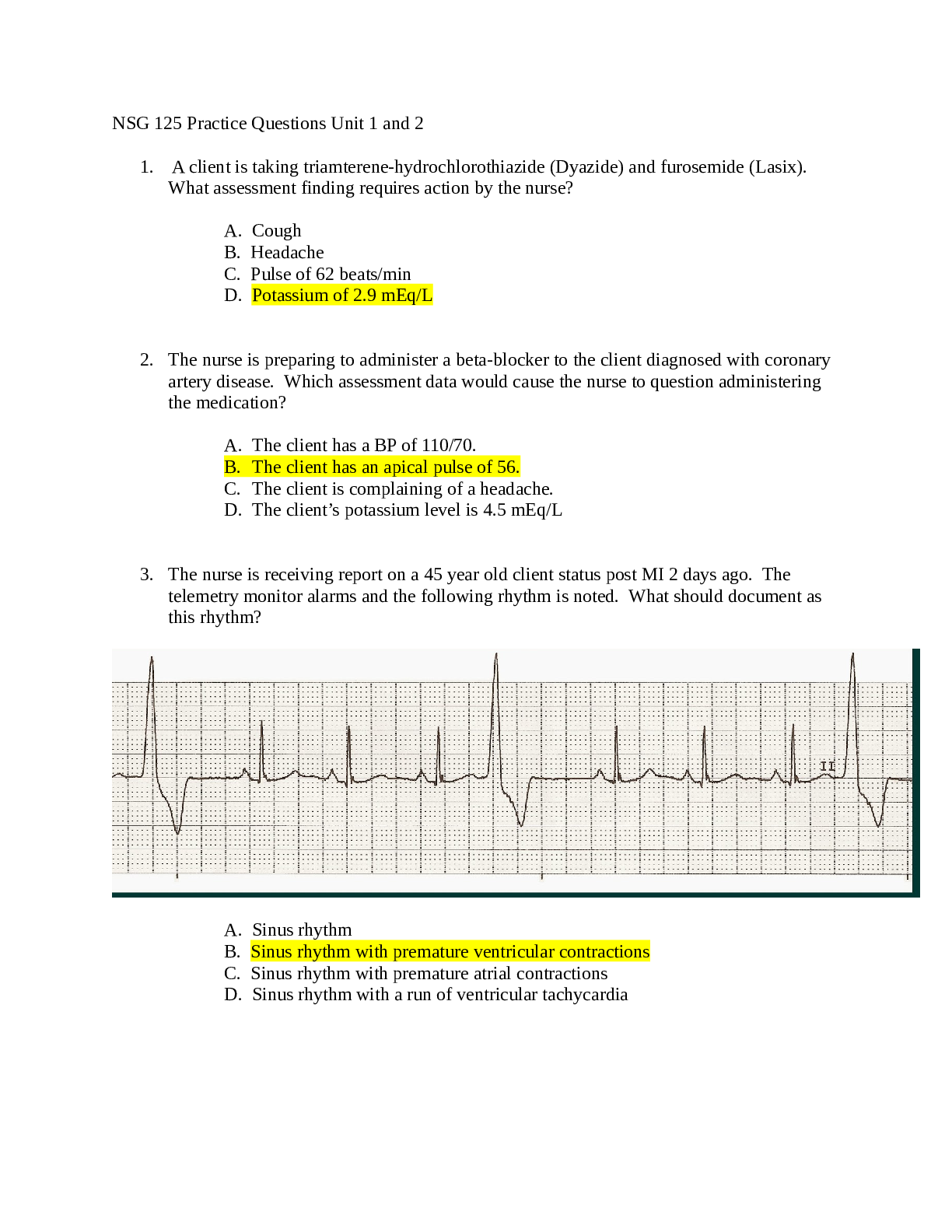
Reviews( 0 )
Recommended For You
*NURSING> QUESTIONS & ANSWERS > NRP 2022 exam/ NRP 7TH EDITION Parts 1 and 2 answered and graded 100% score (All)
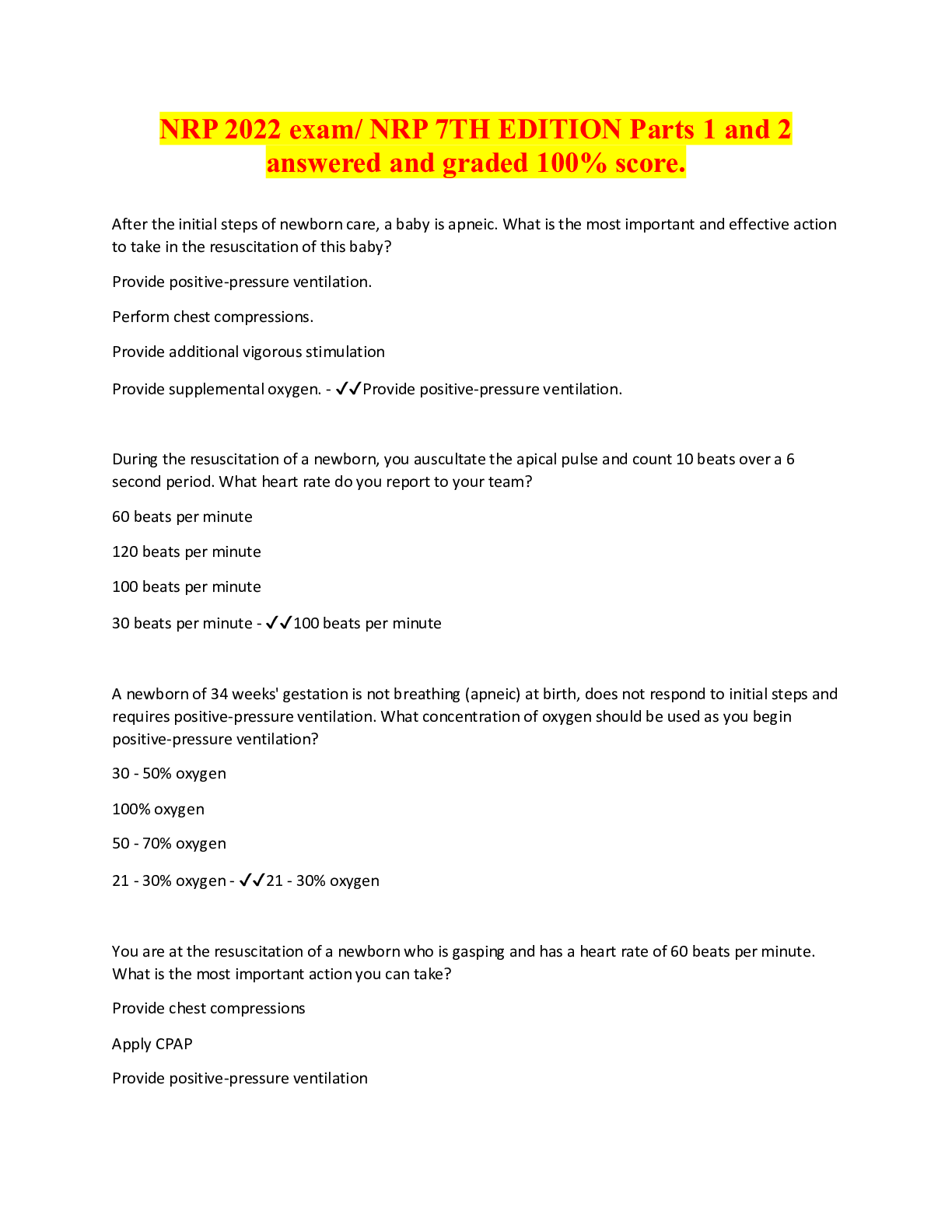
NRP 2022 exam/ NRP 7TH EDITION Parts 1 and 2 answered and graded 100% score
NRP 2022 exam/ NRP 7TH EDITION Parts 1 and 2 answered and graded 100% score. A baby is born at term with a bilateral cleft lip and palate and a very small mandible. She requires positive-pressure v...
By Nutmegs , Uploaded: Jun 23, 2022
$10
*NURSING> QUESTIONS & ANSWERS > NSG 125 Questions Unit 1 and 2 Answered correctly summer 2022. (All)

NSG 125 Questions Unit 1 and 2 Answered correctly summer 2022.
. A client is taking triamterene-hydrochlorothiazide (Dyazide) and furosemide (Lasix). What assessment finding requires action by the nurse? A. Cough B. Headache C. Pulse of 62 beats/min D. Potas...
By MAYEXPERT , Uploaded: Jun 08, 2022
$14
*NURSING> QUESTIONS & ANSWERS > NRP 2022 exam/ NRP 7TH EDITION Parts 1 and 2 answered and graded 100% score. (All)

NRP 2022 exam/ NRP 7TH EDITION Parts 1 and 2 answered and graded 100% score.
NRP 2022 exam/ NRP 7TH EDITION Parts 1 and 2 answered and graded 100% score. A baby is born at term with a bilateral cleft lip and palate and a very small mandible. She requires positive-pressure v...
By Professor Lynne , Uploaded: Jun 01, 2022
$11
*NURSING> QUESTIONS & ANSWERS > NRP 2022 exam/ NRP 7TH EDITION Parts 1 and 2 answered and graded 100% score. (All)

NRP 2022 exam/ NRP 7TH EDITION Parts 1 and 2 answered and graded 100% score.
A baby is born at term with a bilateral cleft lip and palate and a very small mandible. She requires positive-pressure ventilation because she is not breathing. You are unable to achieve a seal with...
By bundleHub Solution guider , Uploaded: May 26, 2022
$7
*NURSING> QUESTIONS & ANSWERS > NRP 2022 exam/ NRP 7TH EDITION Parts 1 and 2 answered and graded 100% score. (All)

NRP 2022 exam/ NRP 7TH EDITION Parts 1 and 2 answered and graded 100% score.
After the initial steps of newborn care, a baby is apneic. What is the most important and effective action to take in the resuscitation of this baby? Provide positive-pressure ventilation. Perform c...
By bundleHub Solution guider , Uploaded: Aug 16, 2022
$9
*NURSING> QUESTIONS & ANSWERS > NRP 2022 exam/ NRP 7TH EDITION Parts 1 and 2 answered and graded 100% score. (All)
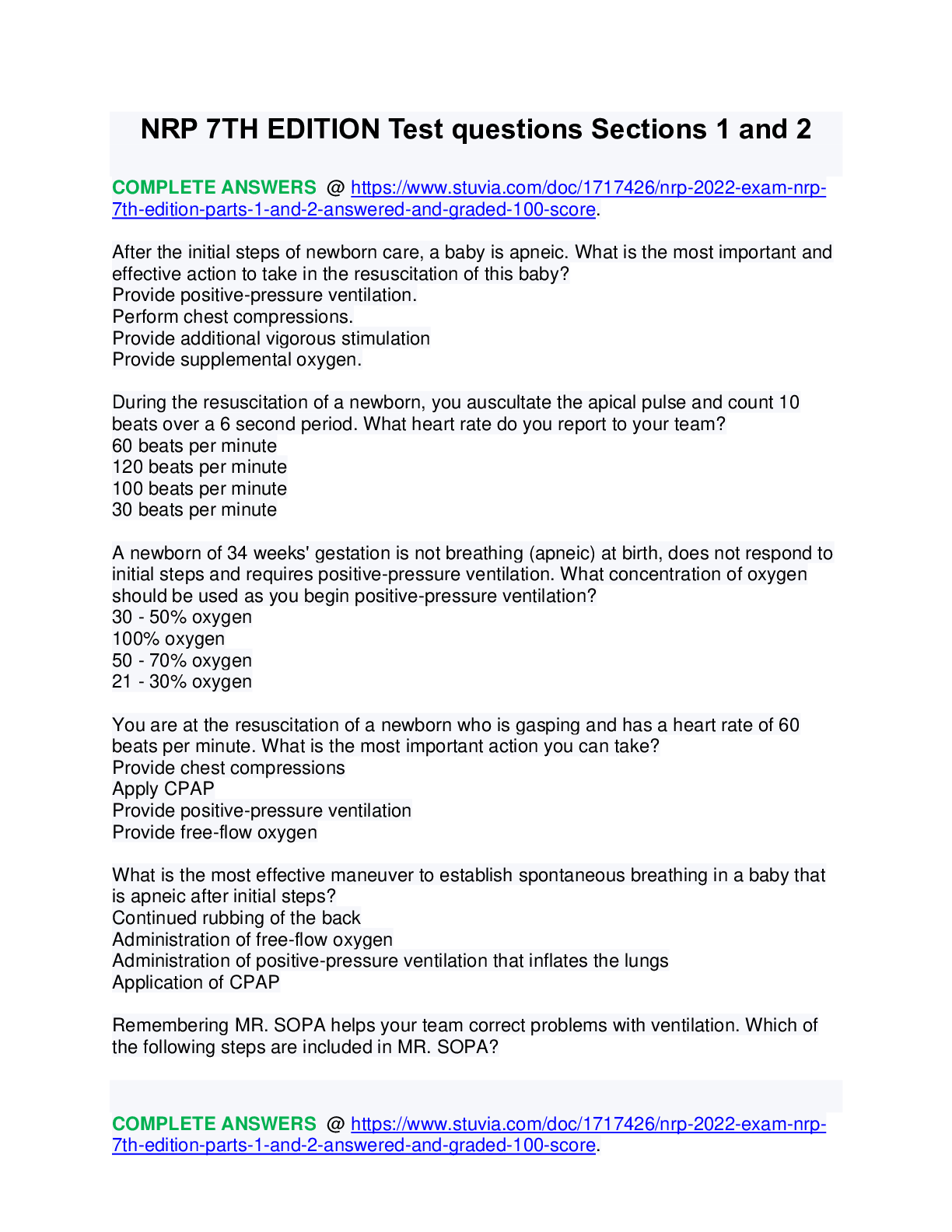
NRP 2022 exam/ NRP 7TH EDITION Parts 1 and 2 answered and graded 100% score.
After the initial steps of newborn care, a baby is apneic. What is the most important and effective action to take in the resuscitation of this baby? Provide positive-pressure ventilation. Perform...
By Jackie09 , Uploaded: Sep 26, 2022
$11
*NURSING> QUESTIONS & ANSWERS > NCSBN TEST BANK for the NCLEX-RN & NCLEX-PN. Contains More than 2000 Q&A Plus Review and Rationale in 517 PAGES. (All)
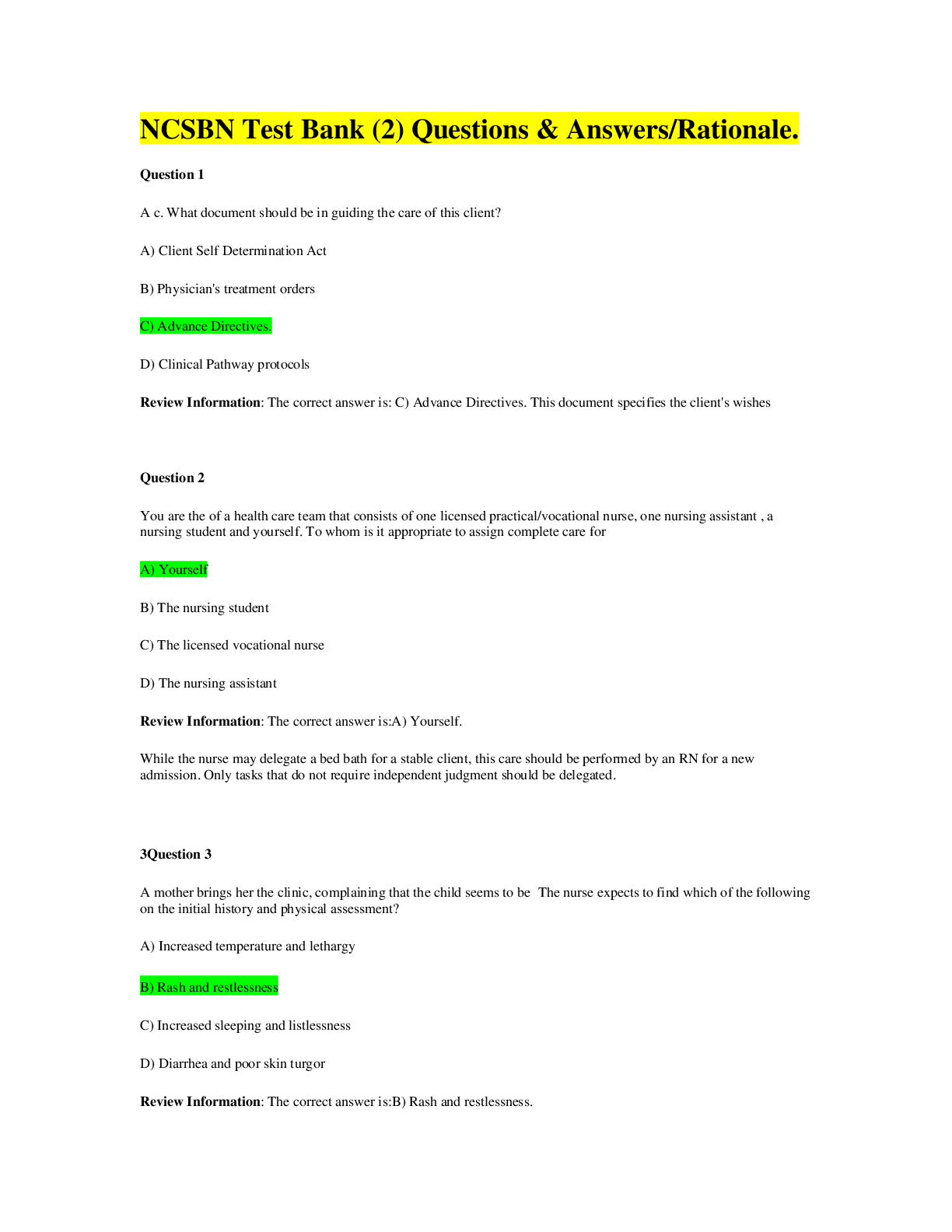
NCSBN TEST BANK for the NCLEX-RN & NCLEX-PN. Contains More than 2000 Q&A Plus Review and Rationale in 517 PAGES.
NCSBN TEST BANK -for the NCLEX-RN & NCLEX-PN. Updated 2022/2023. Contains More than 2000 Q&A Plus Review and Rationale in 517 PAGES. (All Testable Questions for NCLEX-RN & NCLEX-PN)
By Expert1 , Uploaded: Jul 28, 2020
$20
Business> QUESTIONS & ANSWERS > CLM 031 EXAM (All)
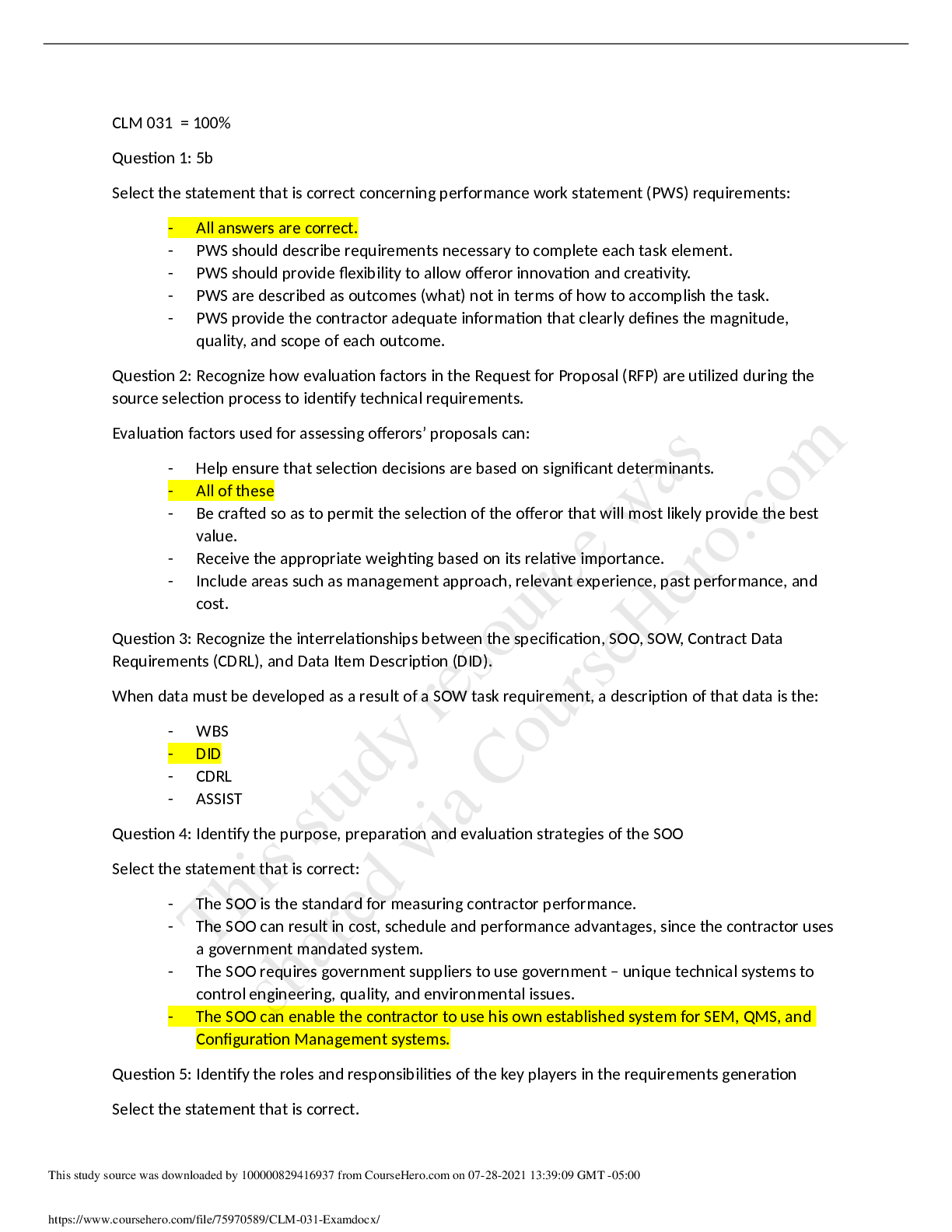
CLM 031 EXAM
CLM 031 = 100% Question 1: 5b Select the statement that is correct concerning performance work statement (PWS) requirements: - All answers are correct. - PWS should describe requirements necessary...
By Book Worm, Certified , Uploaded: Nov 03, 2022
$5
*NURSING> QUESTIONS & ANSWERS > PHIL 347 Week 6 Checkpoint Quiz. Score 100/100 (All)
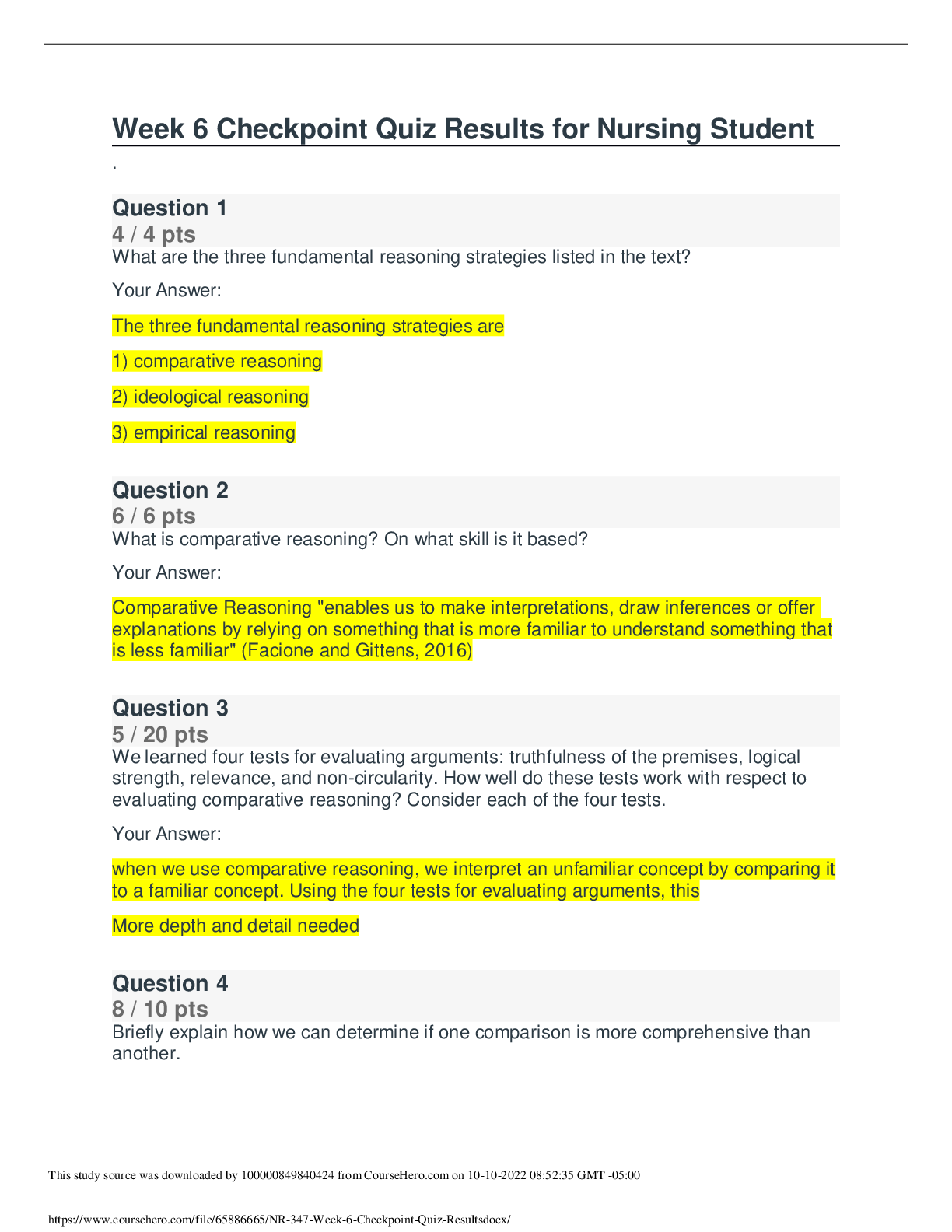
PHIL 347 Week 6 Checkpoint Quiz. Score 100/100
Question: What are the three fundamental reasoning strategies listed in the text? Question: What is comparative reasoning? On what skill is it based? Question: We learned four tests for evaluating...
By Amanda Rosales , Uploaded: Mar 24, 2021
$7
Business> QUESTIONS & ANSWERS > BUSINESS 1007 (All)

BUSINESS 1007
BUSINESS 1007 07 Key 1. (p. 178) Managers utilize organizational resources such as employees, information, and equipment to accomplish goals. 2. (p. 178) The main job of managers today is to w...
By Kirsch , Uploaded: Oct 19, 2019
$6
Document information
Connected school, study & course
About the document
Uploaded On
Jun 05, 2022
Number of pages
15
Written in
Additional information
This document has been written for:
Uploaded
Jun 05, 2022
Downloads
0
Views
83






